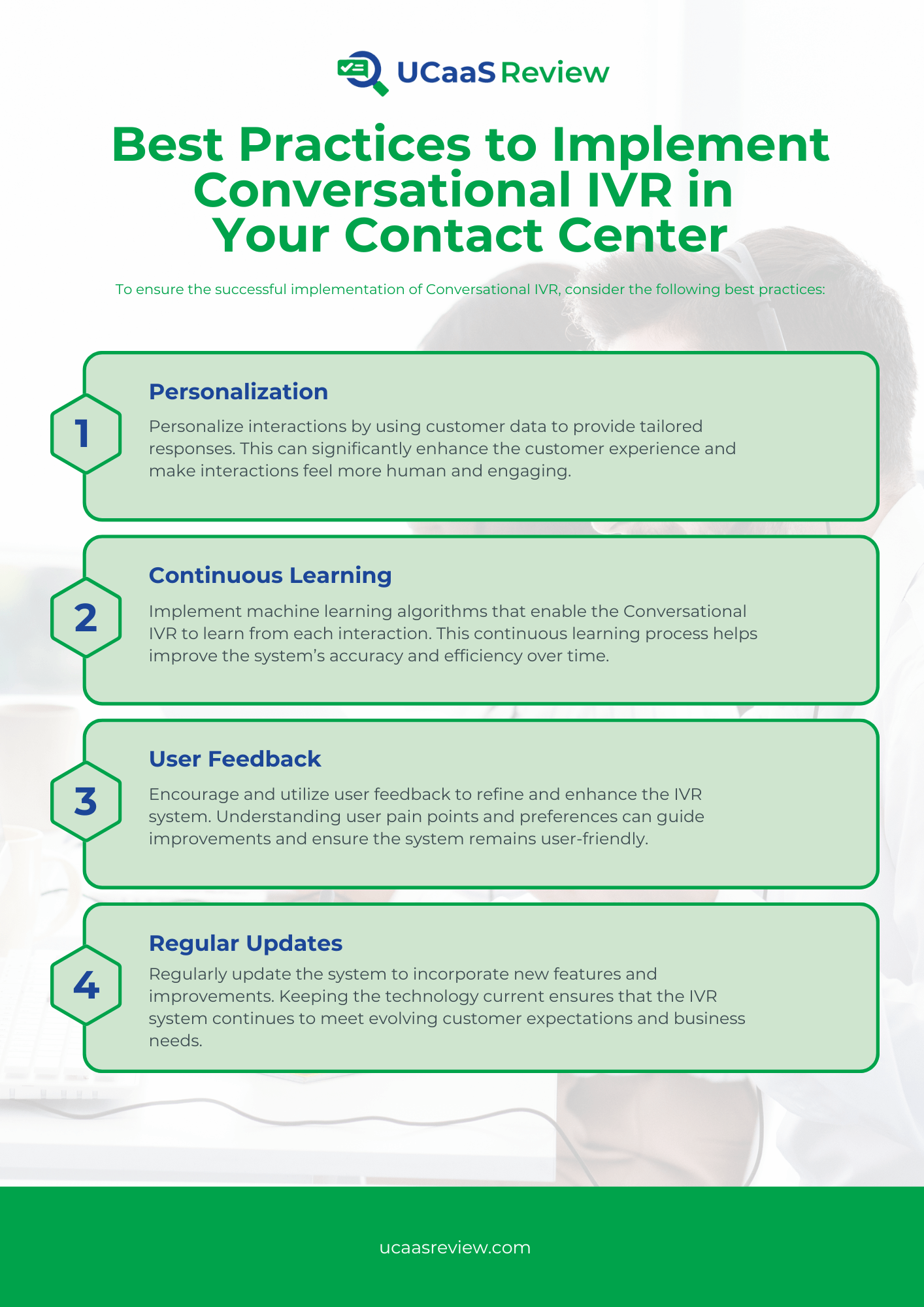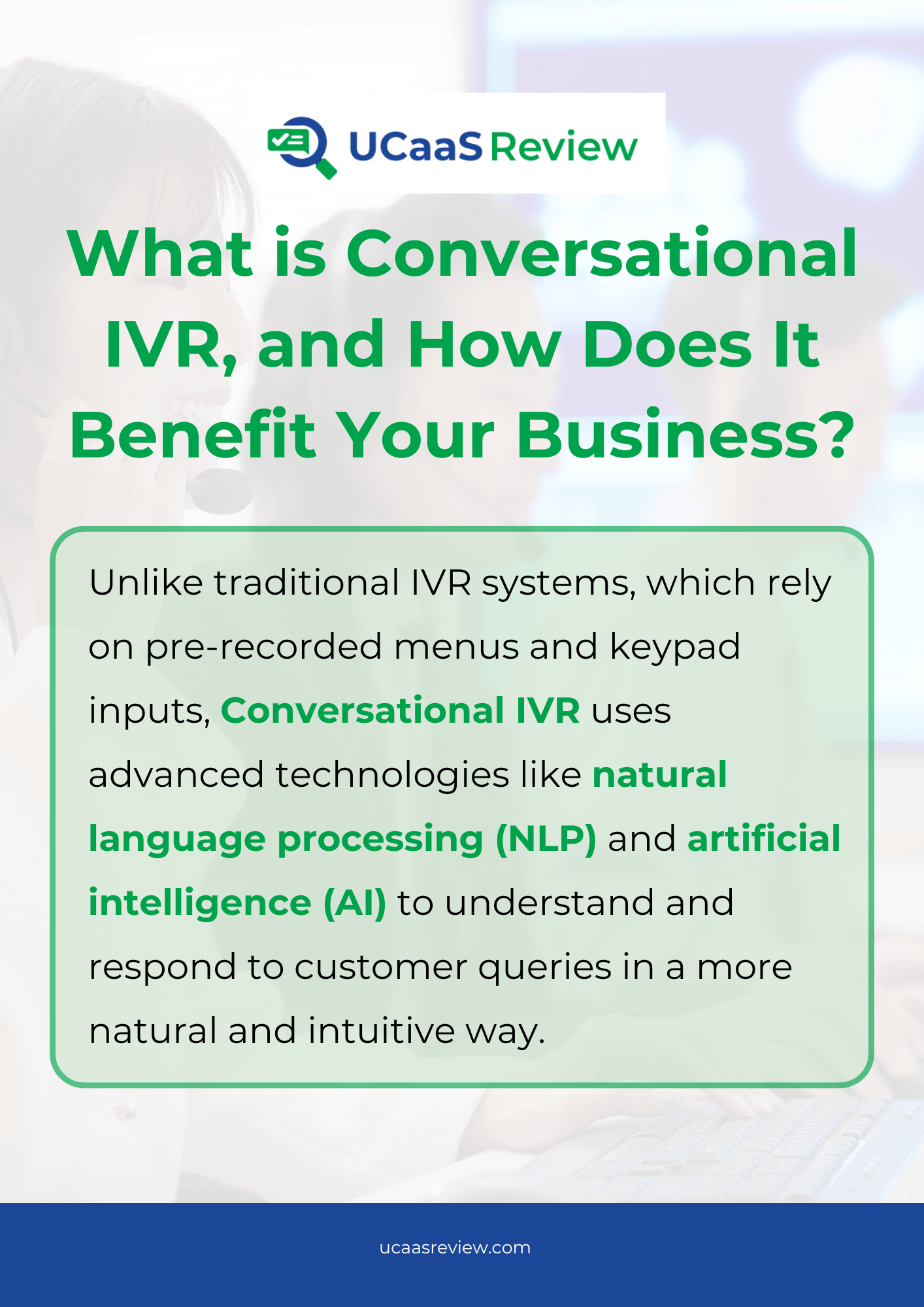Understanding Conversational IVR
Conversational IVR is a significant advancement over traditional IVR systems. Traditional IVR systems operate on a set of pre-recorded messages and keypad inputs, which often lead to frustration as customers navigate through a series of rigid menu options. Conversational IVR, on the other hand, leverages artificial intelligence and natural language processing to understand and respond to customer queries in real-time. This shift allows for more fluid and natural interactions, making the customer experience more pleasant and efficient.
Quick Overview
Conversational IVR integrates AI and NLP to interpret spoken language and respond in a conversational manner. This technology moves beyond simple voice recognition to understanding the context and intent behind a customer’s words. For instance, instead of pressing ‘1’ for account information, a customer can simply state, “I need to check my account balance,” and the system will process this request accordingly.
By reducing the time and effort required to navigate through menu options, it enhances overall customer satisfaction.
Importance for Businesses
For businesses, the adoption of Conversational IVR can lead to significant improvements in customer service metrics. It helps in reducing call handling times and minimizing the need for human intervention, which can lead to cost savings. Additionally, it can handle multiple queries simultaneously, providing quick resolutions without long wait times.
Cost Efficiency
Another major benefit of Conversational IVR is cost efficiency. By automating routine tasks and handling multiple queries simultaneously, Conversational IVR reduces the need for a large number of live agents. This reduction in workforce requirements can lead to significant cost savings for businesses. Additionally, since the system can handle inquiries more quickly and accurately, the overall call duration is reduced, further lowering operational costs.
Moreover, Conversational IVR systems are designed to integrate seamlessly with existing customer service technologies, such as CRM systems and chatbots. This integration allows for more streamlined operations, reducing the need for multiple platforms and the associated costs. Businesses can achieve more with less, optimizing their resources and focusing on more complex customer needs that require human intervention.
Data Collection and Analysis
Conversational IVR systems handle customer inquiries and collect valuable data during interactions. This data includes information on common customer issues, preferences, and behaviors. By analyzing this data, businesses can gain insights into customer needs and trends, allowing them to refine their service offerings and improve overall customer satisfaction.
For instance, if a significant number of customers are inquiring about a specific product feature, a business can identify this trend and address it proactively, either by improving the product or providing additional information through other channels. This proactive approach can lead to better customer experiences and increased loyalty.
Additionally, the data collected can be used to train and improve the Conversational IVR system itself. By learning from past interactions, the system can become more accurate and efficient over time, further enhancing its value to the business.
Enhanced Scalability
Conversational IVR systems offer enhanced scalability compared to traditional IVR systems. As businesses grow and customer interactions increase, these systems can easily scale to handle more calls without a significant increase in costs or resources. This scalability is particularly beneficial for businesses experiencing rapid growth or seasonal spikes in customer inquiries.
Moreover, because Conversational IVR systems can operate continuously without fatigue, they provide consistent service quality regardless of call volume. This reliability ensures that customers always receive the same high level of service, even during peak times.
By integrating these key benefits, businesses can improve their customer service operations and gain a competitive edge in the market. The adoption of Conversational IVR represents a significant step forward in leveraging technology to enhance customer interactions and streamline business processes.
How to Implement Conversational IVR in Your Contact Center
Steps for Implementation
Implementing Conversational IVR in your contact center involves several critical steps to ensure a seamless transition and optimal functionality. Here’s a step-by-step guide to help you get started:
- Determine Business Goals:
Begin by identifying the specific goals you aim to achieve with Conversational IVR. These goals might include reducing call volume, improving call resolution rates, decreasing misrouting, and enhancing overall customer satisfaction. - Choose the Right Platform:
Select a Conversational IVR platform that fits the needs of your organization. Consider factors such as ease of use, scalability, integration capabilities with existing systems, and the level of customization available. - Define Customer Journeys:
Outline the customer journeys that the Conversational IVR will support. These could include common tasks such as account balance inquiries, payment processing, or product information requests. - Design the Conversational Flow:
Create a conversational flow that aims to provide an excellent customer service experience. This involves scripting various interaction scenarios, ensuring the system can handle diverse customer queries smoothly and naturally. - Integrate with Existing Systems:
Ensure that the Conversational IVR integrates seamlessly with your existing customer relationship management (CRM) and telephony systems. This integration is essential for providing a cohesive and efficient service experience. - Test and Refine:
Conduct thorough testing of the Conversational IVR system to ensure it functions as expected. Gather feedback from users and make necessary adjustments to improve the system’s performance and user experience. - Launch and Monitor:
Launch the Conversational IVR system and continuously monitor its performance. Use metrics such as customer satisfaction, call resolution rates, and cost savings to assess the system’s effectiveness and make any necessary adjustments.
Best Practices
To ensure the successful implementation of Conversational IVR, consider the following best practices:
- Personalization:
Personalize interactions by using customer data to provide tailored responses. This can significantly enhance the customer experience and make interactions feel more human and engaging. - Continuous Learning:
Implement machine learning algorithms that enable the Conversational IVR to learn from each interaction. This continuous learning process helps improve the system’s accuracy and efficiency over time. - User Feedback:
Encourage and utilize user feedback to refine and enhance the IVR system. Understanding user pain points and preferences can guide improvements and ensure the system remains user-friendly. - Regular Updates:
Regularly update the system to incorporate new features and improvements. Keeping the technology current ensures that the IVR system continues to meet evolving customer expectations and business needs.

Training Conversational IVR for Accuracy
Training your Conversational IVR system for accuracy is crucial to ensuring that it delivers a seamless and satisfying customer experience. Here are some best practices to help you optimize your system:
Training Techniques
- Start with a Comprehensive Dataset:
Use a diverse and extensive dataset to train your Conversational IVR. This dataset should include various dialects, accents, and conversational scenarios to ensure the system can understand and respond to a wide range of inputs. The more comprehensive your dataset, the better your system will perform in real-world situations. - Incorporate Machine Learning:
Leverage machine learning algorithms that enable the system to learn from each interaction. This continuous learning process helps the system adapt and improve over time, making it more accurate and efficient. Machine learning can help identify patterns and common phrases, enhancing the system’s ability to understand and respond appropriately. - Utilize Natural Language Processing (NLP):
Implement advanced NLP techniques to enhance the system’s ability to understand context and intent. NLP allows the IVR to interpret nuances in language, such as slang, idioms, and colloquial expressions, which are essential for providing accurate responses. - Simulate Real-Life Scenarios:
Conduct extensive testing using real-life scenarios to identify potential issues and areas for improvement. Simulating actual customer interactions can help uncover weaknesses in the system and provide insights into how it can be enhanced. - Incorporate Feedback Loops:
Establish feedback loops to gather insights from both customers and agents. This feedback can be used to refine the system and address any recurring issues. Regularly updating the IVR based on user feedback ensures that it remains effective and accurate. - Regular Updates and Maintenance:
Regularly update the system to incorporate new data and improvements. Keeping the system current with the latest developments in AI and NLP ensures that it continues to meet customer expectations and handles inquiries accurately. - Human Oversight:
Include a human-in-the-loop approach where necessary. For complex or unclear interactions, having human oversight can help train the system to handle similar situations in the future. This approach ensures that the IVR system continues to improve while maintaining a high level of accuracy. - Monitoring and Evaluation
Monitor key performance indicators (KPIs) such as call resolution rates, customer satisfaction scores, and average handling times. These metrics provide valuable insights into the system’s performance and highlight areas that require improvement.
Future Trends in Conversational IVR Technology
Enhanced Emotional Intelligence
One of the most exciting trends is the development of IVR systems with enhanced emotional intelligence. Future Conversational IVR systems are expected to not only understand the content of a customer’s speech but also detect and respond to the emotional state of the caller. These systems can provide more empathetic and appropriate responses by analyzing voice tone, pitch, and other vocal cues. This ability to gauge emotions will significantly improve customer satisfaction by making interactions feel more personalized and human.
Integration with Advanced Analytics
Advanced analytics and big data are set to play a crucial role in the future of Conversational IVR. By integrating with sophisticated analytics platforms, IVR systems will be able to provide deeper insights into customer behavior and preferences. This integration will allow businesses to predict customer needs more accurately and tailor their services accordingly. Moreover, real-time analytics can help monitor system performance and identify improvement areas, ensuring that the IVR system remains effective and efficient.
Voice Biometrics for Enhanced Security
As security concerns continue to rise, the adoption of voice biometrics in Conversational IVR systems is becoming increasingly important. Voice biometrics can be used to authenticate callers based on unique vocal characteristics, providing a secure and seamless verification process. This technology enhances security and improves the user experience by eliminating the need for traditional, cumbersome authentication methods such as passwords or security questions.
Multilingual Capabilities
The global nature of business today requires IVR systems that can cater to a diverse customer base. Future Conversational IVR systems are expected to offer robust multilingual capabilities, allowing customers to interact in their preferred language. Advanced NLP algorithms will enable these systems to understand and respond accurately in multiple languages, breaking down language barriers and enhancing accessibility for a broader audience.
Integration with IoT Devices
The Internet of Things (IoT) is revolutionizing various industries, and its integration with Conversational IVR systems is a trend to watch. IVR systems connected to IoT devices can provide more comprehensive support by accessing real-time data from these devices. For example, in a smart home setup, a Conversational IVR system could assist with controlling home appliances or troubleshooting issues by directly interacting with connected devices.
Proactive Customer Engagement
Future Conversational IVR systems will move beyond reactive customer service to proactive engagement. Using predictive analytics, these systems can anticipate customer needs and reach out with relevant information or assistance before the customer even makes contact. This proactive approach can significantly enhance customer satisfaction and loyalty by demonstrating a business’s commitment to meeting customer needs efficiently.
Transform Your Customer Experience Today
Are you ready to revolutionize your customer service operations? Don’t wait to enhance your customer experience and stay ahead of the competition.
Reach out to our team of experts to learn more about different providers and how to get started on the path to a more efficient and customer-centric operation.



